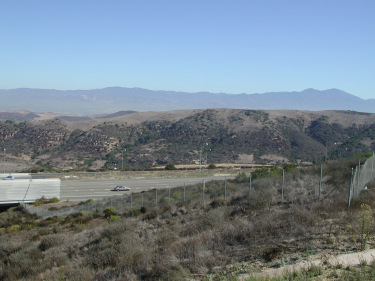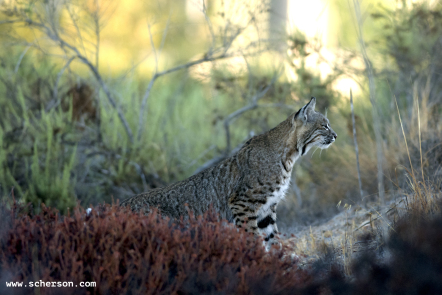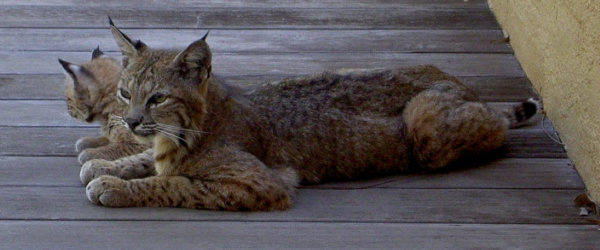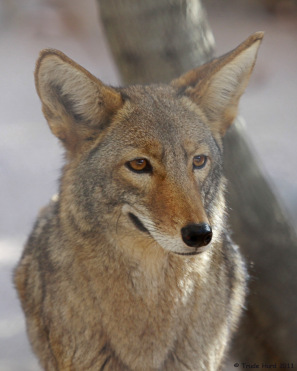
Orange County’s plants and animals are adapted to the unique conditions of California’s mediterranean climate, with its cool, wet winters (when water and food is most abundant), and dry, hot summers (when some resources are scarce). While the rest of the country’s plant life is largely dormant in winter due to cold temperatures and frozen water, OC residents can enjoy at least some native plants blooming. On the flip side, some animals and plants are dormant in August, while many other states are experiencing the peak of annual growth and rain. Similarly, animals must also adapt to these changing environmental conditions, in part by moving from place to place in search of food, mates, hunting grounds, and safe places to raise their babies. Historically, movement across the landscape and normal part of animal and plant life, and this is true of the flora and fauna in Orange County.
 People have converted many acres of land in Orange County from wild land to streets, homes, shopping centers, etc. As more and more wild land becomes developed, and obstacles begin to appear in places where animals previously roamed and foraged freely – this is known as habitat fragmentation.
People have converted many acres of land in Orange County from wild land to streets, homes, shopping centers, etc. As more and more wild land becomes developed, and obstacles begin to appear in places where animals previously roamed and foraged freely – this is known as habitat fragmentation.
Fragmentation is one of the major causes of problems for wildlife in urban areas around the world. Habitat fragmentation can keep animals from moving to new territories, eventually isolating them on a virtual ‘island’, and preventing them from finding mates that have the genetic diversity needed to keep the animal population healthy. For example, one very serious barrier to movement is the freeway system in southern California. It is very difficult and dangerous for animals to cross a freeway, and for many animals, crossing to the other side is simply not an option. However, some larger animals will attempt to cross a freeway and when they do, they are sometimes hit by vehicles. In southern California, mountain lions often make headlines when they cross highways, or die trying.
Across the United States and the world, some land has been preserved as wildlife corridors (sometimes called greenbelts). In Orange County, local residents, governments, developers, and nonprofit organizations have worked together for decades to preserve over 22,000 acres along the Laguna Coast and elsewhere, and invested millions of dollars in preserving these acres. In order to protect this huge investment, the Irvine-Laguna Wildlife Corridor is essential; It keeps wildlife populations healthy by connecting them to new territories to find suitable mates and other essential resources they need to t thrive.
Bobcat (Lynx rufus)

Photo by Sandrine Scherson
Known for their short ‘bobbed’ tails, bobcats are abundant throughout North America and seem adaptable to urbanization, but still face some serious challenges. These wild cats about twice the size of a house cat; in southern California adult males weigh about 21 pounds, and females weigh about 15 pounds. Bobcats are solitary (both males and females protect territories called ‘home ranges’) and famous for avoiding humans. In urban areas, bobcats often become nocturnal (active only at night), and sightings are rare. Even so, in recent years, bobcat sightings have become more common in Orange County, demonstrating that wild animals sometimes change their behavior to adjust to their urban surroundings. Unlike coyotes, who are omnivores (eat many things), these felines are strictly carnivores, and in Southern California, they eat gophers, rabbits, woodrats, squirrels, mice, and lizards, among other small animals. They look for abandoned woodrat nests or other cozy places to use as dens for their litters of kittens. In rare cases, they will even take up residence in buildings. They use the dens for a few months after the birth of their litter – typically between two and four kittens (although scientists studying bobcats in the Santa Monica Mountains have observed some mother bobcats with five kittens).
Poisons aimed at killing rodents (such as rats) or other pests are one of the biggest threats to bobcats and other top predators. Even if a bobcat doesn’t eat the poison directly, it may eat other animals that have ingested it, and can suffer from poisoning or a compromised system that makes it less resilient to diseases (such as mange). Scientists and wildlife officials in our region have cautioned against using these poisons. Other threats to bobcats are diseases that are passed to them from domestic cats and dogs. All pet owners should be careful to prevent their pets from roaming free for the health of wildlife in our region.
Bobcats are also affected by the fragmentation of their habitat in Orange County. As with other animals, large roads and swaths of development can be a major hurdle to bobcats who need to move throughout the region. The animals become isolated onto small ‘islands’, which can cause low population

A female bobcat rests with her cub on a porch in Irvine, California
numbers and too little genetic diversity, and this puts the animals at risk for health problems. In Orange County, recent studies have shown that bobcats in the coastal region are genetically different from adjacent areas. This has also been happening to bobcats in the Los Angeles region. These bobcats are starting to show signs of health problems related to genetic isolation. One way to combat this inbreeding is to provide a safe route to larger wild lands so that bobcats can find mates that will help the next generation of bobcats have more robust genes.
Laguna Greenbelt, Inc. continues to advocate for the completion of the Irvine-Laguna Wildlife Corridor in order to provide a reliable route for wildlife movement between the Laguna coastal open spaces and the Santa Ana Mountains. This will help keep our beloved bobcat populations safe and healthy.
For more information about bobcats and the challenges they face in urban places please visit:
Citizens for Los Angeles Wildlife
Coyote (Canis latrans)
“Orange County’s Keystone”

This coyote was photographed at the Orange County Zoo. Female coyotes can weigh between 22 and 35 pounds, while males are larger – between 25 and 45 pounds. Those in western states tend to be smaller than their eastern counterparts.
Coyotes, members of the same taxonomic families as wolves, foxes, and the family dog, may be one of the most well-known of our wild neighbors; They increasingly make headlines as people encounter them in urban and suburban neighborhoods. These highly adaptable social animals live in family groups of two to ten adults plus pups. They are often seen alone, as they hunt and forage alone or in loose pairs. Some young coyotes between 6 months and 2 years old may leave family groups and become solitary travelers as they look for another pack to join or a new territory. Unlike mountain lions and bobcats in Orange County, coyotes are omnivores; like us, their diet consists of many different foods, and may be 60% plant material. Researchers have found that they also eat a variety of small animals, depending on the season. They are opportunistic foragers; able to adjust their foraging hours to fit the situation. In our communities they will eat pet food, go through piles of garbage or carry off small pets left unattended. This makes some people fearful and angry.
Coyotes are essential for the wellbeing of the ecosystem. Coyotes discourage or reduce the number of raccoons, foxes, skunks, opossums, and feral cats – the natural predators of local birds and other small animals. Coyotes are the ‘keystone species’ of Orange County’s scrub communities–critical to keeping the ecological balance and preserving natural habitats. The name comes from the top piece in a Roman arch, a wedge-shaped piece that is the last stone hammered into place. Without the keystone, the archway cannot withstand the force of gravity, and it collapses. The ecologist Michael Soulé, studied 37 wild canyons next to urban development in San Diego. Coyotes were found to be the difference between keeping native birds and small wildlife or losing them in a few years. Canyons large enough or connected enough to other wild lands to have coyotes continued to have thriving native bird and mammal populations. But, in canyons with no coyotes, native wildlife was almost eliminated by the assault of bobcats, foxes, raccoons, skunks, and feral cats.
In fact, coyotes are so important that wildlife agencies require builders to leave coyote corridors between wild areas when development encroaches. In Orange County, coyotes are vital to our ecosystem’s health, and they travel long distances to find food for their families. Wildlife corridors are necessary to provide a safe and direct route between parks and other protected lands, and will help encourage coyotes to stay out of people’s yards.
If we’re not careful, we can create problem wildlife. People often tempt coyotes – sometimes on purpose, and sometimes by accident – by not securing their trash cans, leaving pet food in the yard, or leaving their pets unsupervised out-of-doors. Sometimes, coyotes begin to prefer these human food sources and become aggressive. In the past, ‘problem’ animals have been (often unsuccessfully) relocated, or killed, by animal control officers. Luckily, the approach is changing. California’s Department of Fish and Wildlife and many cities in southern California have switched to hazing methods, in which they scare the coyotes and try to maintain their fear of humans and human settlements. Essentially, the goal is to prevent the urbanization of these wild coyotes. The best way to keep people secure and coyotes safe is for them to stay wild. It’s important to never leave trash, food, or pets outside where coyotes or other wild animals may have access. Additionally, if you see a coyote, try to scare it away by waving your arms, standing up tall, yelling, or making noise to scare away the animal. “Never let a coyote go by without hazing it.”
For more information on coyotes, visit:
